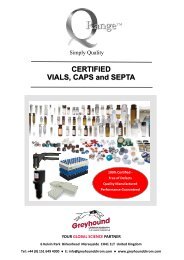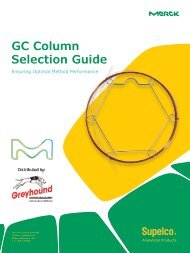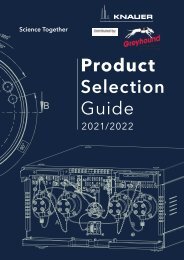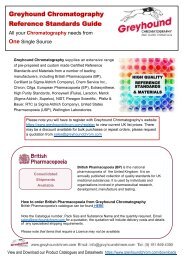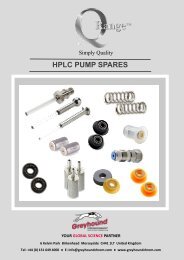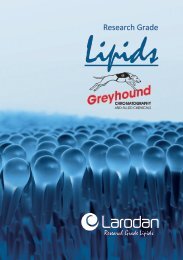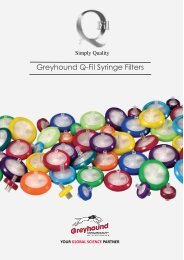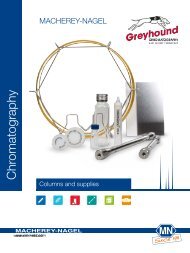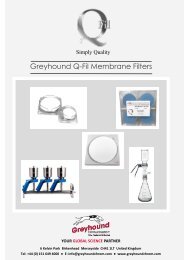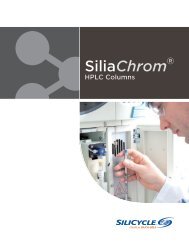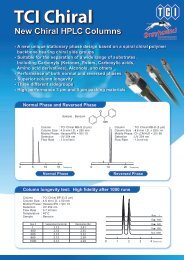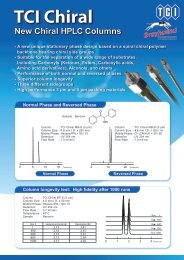Create successful ePaper yourself
Turn your PDF publications into a flip-book with our unique Google optimized e-Paper software.
SYRINGE TECHNICAL REFERENCE | FREQUENTLY ASKED QUESTIONS<br />
Syringe Questions<br />
What is the accuracy<br />
1 6<br />
of <strong>Hamilton</strong> syringes?<br />
2<br />
3<br />
4<br />
5<br />
<strong>Hamilton</strong> syringes are manufactured to be accurate<br />
within ±1% of nominal volume, and with precision<br />
within 1%, measured at 80% of total scale volume.<br />
Our ISO 9001-<strong>20</strong>08 certified Quality System uses<br />
rigorous testing and quality checks to ensure the<br />
highest levels of accuracy and precision. To obtain<br />
a syringe-specific certificate the syringe must be<br />
purchased as a Calibrated Syringe (page 26).<br />
Can <strong>Hamilton</strong> syringes<br />
be used on humans?<br />
No, <strong>Hamilton</strong> syringes are labeled “Not for Human<br />
Use”. To discuss potential off label uses for <strong>Hamilton</strong><br />
syringes please contact us.<br />
Are the plungers for the Microliter<br />
syringes (600, 700, and 800 series)<br />
interchangeable?<br />
No, each plunger is hand-fitted to the corresponding<br />
syringe barrel. Be very careful to keep each plunger<br />
with its original syringe barrel in order to maximize<br />
syringe performance.<br />
The plungers on the 700 series<br />
syringes move when very little force<br />
is applied. Can this be prevented?<br />
The plungers on Microliter syringes are designed<br />
to move freely to enable rapid injection into a GC.<br />
If more resistance is desired a Gastight syringe is<br />
recommended. The Gastight plunger uses a plastic<br />
seal between the plunger and syringe barrel, resulting<br />
in additional drag force to move the plunger.<br />
What are the most versatile<br />
syringes made by <strong>Hamilton</strong>?<br />
In our opinion, Gastight syringes with the Removable<br />
Needle termination are the most versatile. The plungers<br />
and the needles are replaceable if they get bent<br />
or wear out. Additionally, the dead volume of the<br />
Removable Needle termination is as small as a<br />
Cemented Needle syringe which is critical for small<br />
volume syringes.<br />
7<br />
8<br />
9<br />
Why doesn’t my RN adapter<br />
fit onto my RN syringe?<br />
The RN adapters are compatible with any SampleLock<br />
syringes or with Removable Needle syringes between<br />
250 µL – 10 mL. If the proper size syringe is being used<br />
it is possible that the white ferrule from the previously<br />
installed needle is still stuck in the hub. This must be<br />
removed prior to installation of the RN adapter.<br />
How do I adjust the needle exposure<br />
on my Neuros syringe?<br />
To expose the needle loosen the RN nut on the end<br />
of the adapter, and then gently push the needle sleeve<br />
down. Be careful not to put your finger over the needle<br />
hole when moving the needle sleeve down. Sometimes<br />
the needle sleeve may be a little tight when using it for<br />
the first time.<br />
Do the 7000 series Neuros syringes<br />
have replacement parts?<br />
No, due to the design of the 7000 series needle<br />
plunger assembly the 7000 series Neuros<br />
syringes do not have any replacement parts.<br />
How do you backfill syringes?<br />
Backfilling a syringe can be useful when the syringe<br />
is connected to a needle or tubing with a large dead<br />
volume. Excessive dead volume makes the system<br />
difficult to prime and filling from the back may be<br />
the only option. Backfilling should not be used if the<br />
needle is clogged because reinsertion of the plunger<br />
can result in excessive backpressure and a cracked<br />
syringe barrel.<br />
To backfill a <strong>Hamilton</strong> syringe, simply remove the<br />
plunger and load the solution from the back using a<br />
second syringe. Once the air bubbles are flushed out<br />
remove the second syringe and reinsert the plunger.<br />
For this purpose <strong>Hamilton</strong> offers a Priming Kit<br />
(P/N PRMKIT) which is recommended for syringes<br />
as small as 5 µL.<br />
Note: This procedure is valid for 700<br />
and 1700 series syringes only.<br />
87



